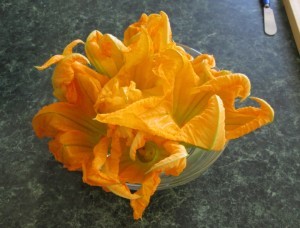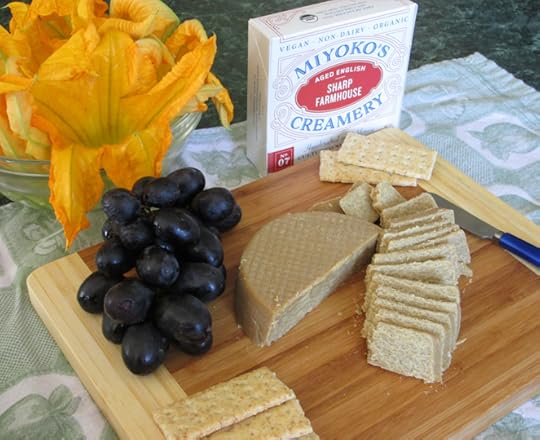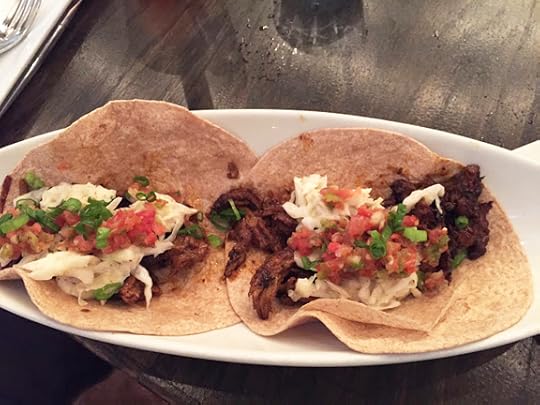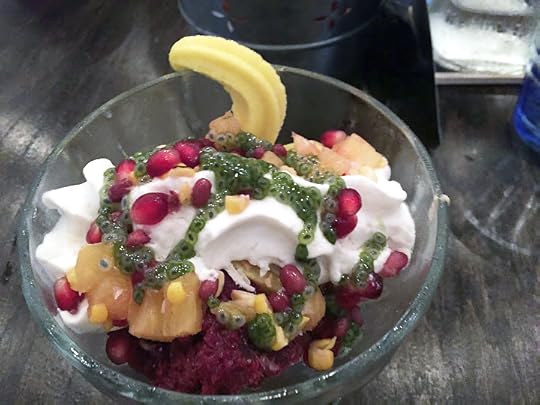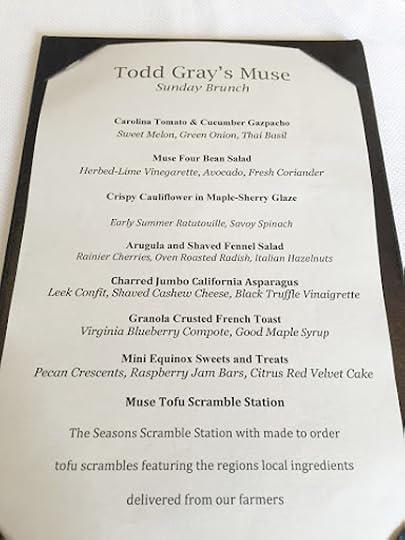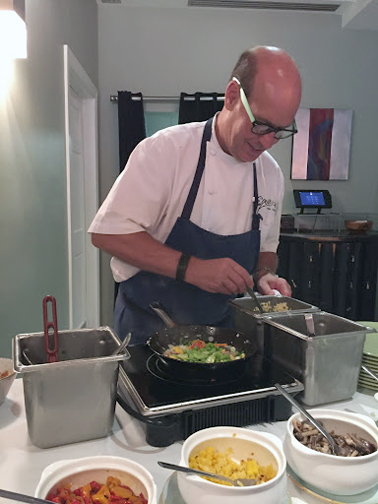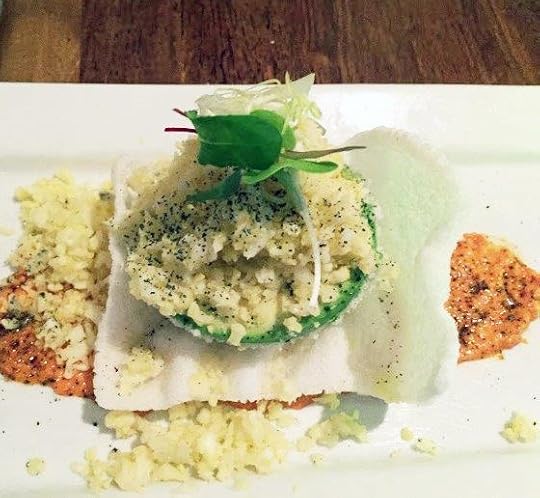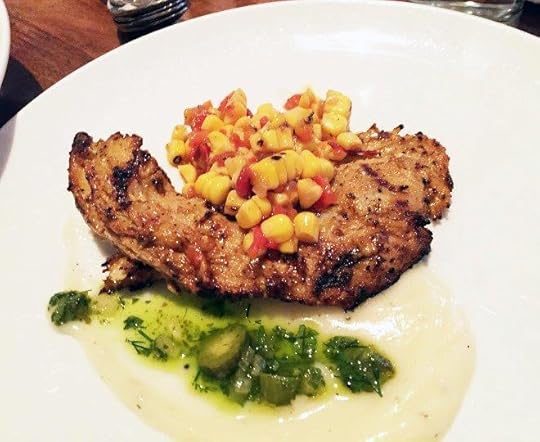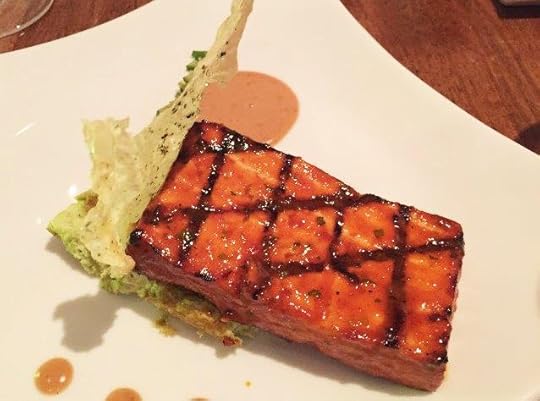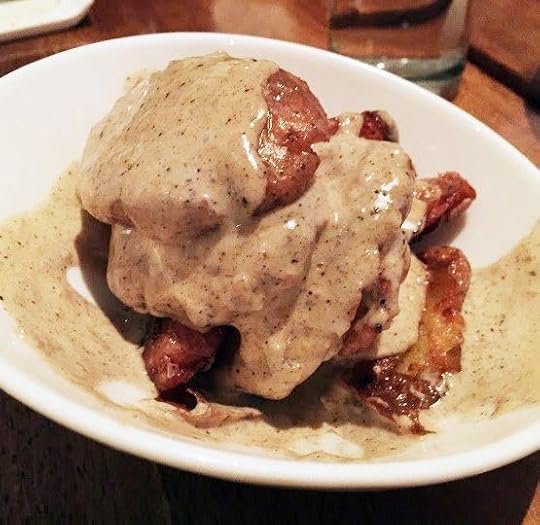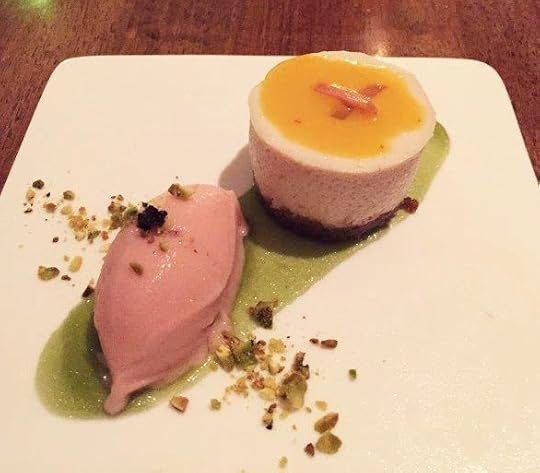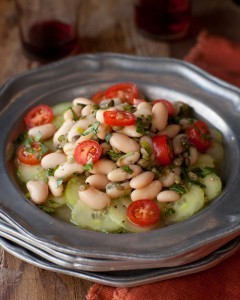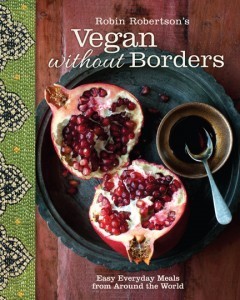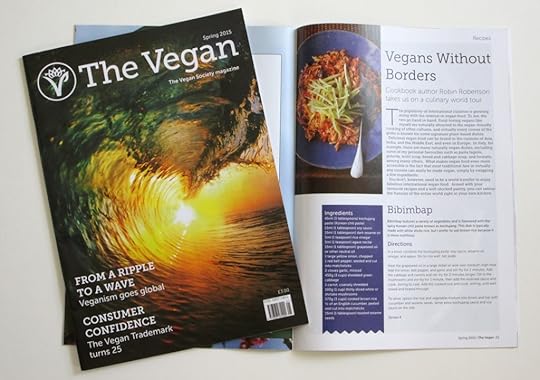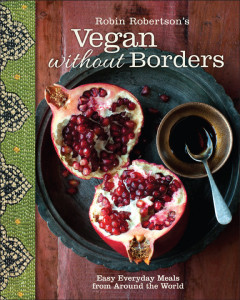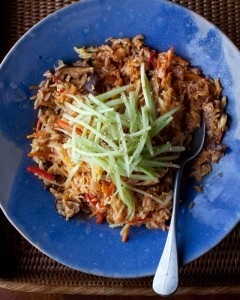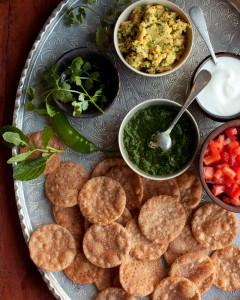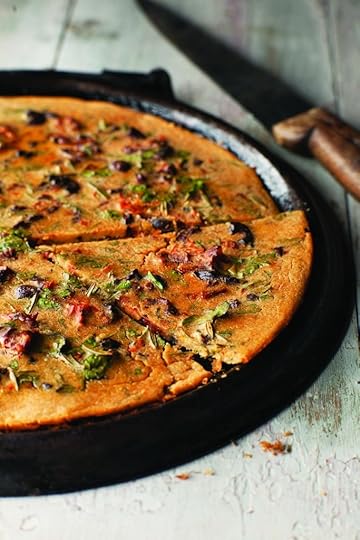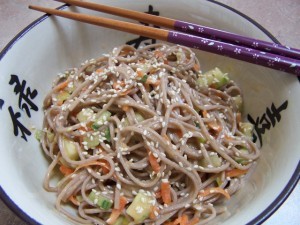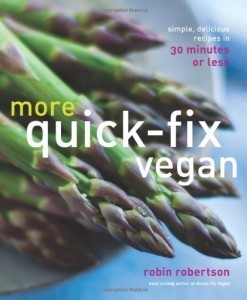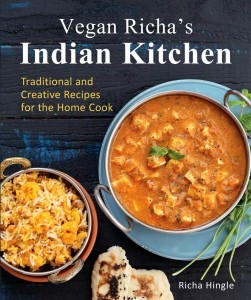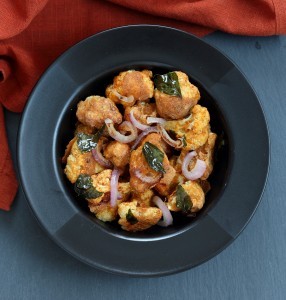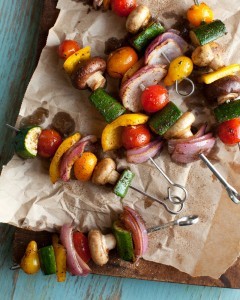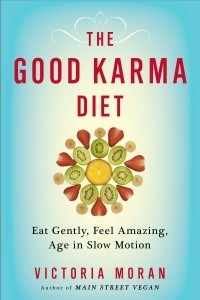Robin Robertson's Blog, page 17
July 21, 2015
Ratatouille and Other Summer Pleasures
So far this summer has been punctuated by heat, humidity, and lots of rain. I’d gripe about the weather if it weren’t for the lovely produce that has been popping up all over because of it. Just this week a dear friend gifted me with loads of veggies, including this study in green:
The zucchini, peppers, and (ripe) tomatoes went into my favorite summer vegetable dish — ratatouille (shown above, photo by Sara Remington). The recipe is at the end of this post — it’s from my book, Vegan Without Borders.
Our friend also brought us these zucchini blossoms, which I cooked up almost as soon as I got them — (and which we inhaled before I could snap a photo.) Here they are before cooking….
In between all the fresh produce, we’ve been happily nibbling on some of the delicious cheeses from Miyoko’s Kitchen, including Fresh Loire Valley in a Fig Leaf — almost too pretty to eat. I served the Aged English Smoked Farmhouse to my friend who brought over the veggies — it was so good with the black seedless grapes that I served with them. While I do enjoy making my own cheese on occasion, it’s such a treat to dig into all the amazing varieties that Miyoko has come up with. I highly recommend them to any former (or current) cheese lovers.
Now, here’s that recipe I promised for the ratatouille. It may seem to hot to be roasting vegetables, but roasting them really intensifies their flavors in this dish which is further enhanced by the addition of basil pistou. It’s great served with a warm crusty baguette.
Roasted Ratatouille with Basil Pistou
This recipe is from Vegan Without Borders (c) 2014 by Robin Robertson, published by Andrews McMeel Publishing.
1 large yellow onion, chopped
1 eggplant, peeled and cut into 1/2-inch dice
2 zucchini, halved lengthwise and cut into 1/4-inch slices
1 red bell pepper, seeded and chopped
2 cups cherry or grape tomatoes, halved lengthwise
3 to 5 cloves garlic cloves, chopped
1 teaspoon fresh or dried thyme
1 teaspoon dried marjoram
1/2 teaspoon dried oregano
Salt and freshly ground black pepper
2 tablespoons olive oil
3 tablespoons Basil Pistou (recipe follows)
2 tablespoons chopped fresh Italian flat-leaf parsley
Preheat the oven to 425 degrees F. Lightly oil a large baking dish or roasting pan.
In a large bowl combine the onion, eggplant, zucchini, bell pepper, tomatoes, and garlic. Sprinkle on the thyme, marjoram, and oregano and season generously with salt and pepper to taste. Drizzle on the oil and toss to combine. Spread the vegetable mixture into a large baking pan. Roast until the vegetables are tender, about 45 minutes, turning once or twice to cook evenly. To serve, transfer to a serving bowl, add the pistou and parsley and toss to combine. Taste and adjust the seasonings, if needed. Serve hot.
Serves 4 to 6
Basil Pistou
Pistou is the French version of basil pesto. Made without cheese or pine nuts, pistou can be used in the same ways as pesto: as a pasta sauce, in salad dressings or soups, or to flavor vegetable dishes, as it does in the Roasted Ratatouille (page 000). Best of all, it freezes well, so portion it into 1- or 2 2-tablespoon amounts and freeze for later use.
2 cups packed fresh basil leaves
4 cloves garlic cloves, chopped
1/4 cup olive oil
1/2 teaspoon salt
A few grinds of freshly ground black pepper
In a food processor, combine the basil leaves, garlic, olive oil, salt, and pepper. Process until thoroughly blended, scraping down the sides as needed. Transfer to a container with a tight-fitting lid. Use immediately or cover and refrigerate until needed.
Makes about 2/3 cup pistou
The post Ratatouille and Other Summer Pleasures appeared first on Robin Robertson.












July 9, 2015
V Street and Equinox – Birthday Weekend Part Two
Before much more time passes, I want to share more pix from my recent food-and-fun-filled birthday weekend extravaganza.
After enjoying dinner at Vedge in Philadelphia on my birthday evening, the next day we all went to lunch at V Street – the casual sister restaurant of Vedge.
While most of us at the table couldn’t resist the BBQ SEITAN TACOS served with hearts of palm slaw on flour tortillas (shown at top), one person couldn’t resist the siren song of the KOREAN FRIED TEMPEH REUBEN with sriracha thousand island and radish kimchee — and you can see why:
Too full for dessert, we got a couple of these beauties to share. It’s called AIS KACANG and is a refreshing ice cream sundae made with corn custard ice cream, blackberry granita, adzuki, basil, and pineapple. So good!
Not long after lunch, we drove back to DC in the pouring rain, stopping for a great Burmese dinner at Mandalay in Silver Spring, MD. (the pics turned out too dark to share….)
The next morning was a long-anticipated sojourn to Equinox, where Chef Todd Gray serves a vegan brunch on Sundays.
Here’s the brunch menu:
This is a shot of the buffet line, which begins with the best gazpacho I’ve ever had:
Here’s the chef at the tofu scramble station where he makes each scramble to order:
That afternoon, it was back home to Virginia with great memories of the best birthday weekend ever!
The post V Street and Equinox – Birthday Weekend Part Two appeared first on Robin Robertson.












July 8, 2015
How to Be Great at Doing Good
In a brief detour from my usual vegan food posts, I want to tell you about a very informative book I’ve read recently called How To be Great at Doing Good. Written by Nick Cooney, Director of Education at Mercy For Animals and founder of The Humane League, this book can be a helpful tool in making decisions about charitable donations.
Nick agreed to answer some questions about his book, so without further ado, here’s my Q&A with Nick Cooney:
Q: What is it you want us to know about “How To Be Great At Doing Good” and how does that apply to vegan eating?
A: While there are a lot of reasons to eat vegan meals – including because they’re simply delicious – a lot of people do so in order to protect animals, boost their health, or preserve the environment. In other words, we have some noble reasons for cutting out animal products. And for that reason, many of us like to spread the word about vegan eating to our friends, family, co-workers, and even strangers.
But anytime we have a charitable cause or better way of doing things that we’re trying to promote – be it vegan eating or anything else – there are good and bad ways of going about it. This book is about how to find the good ways of supporting the vegan cause, or any cause.
Q: This seems like a book that would be useful for people who donate to charity – is that one of your audiences?
A: Absolutely. One of the main goals of the book is to help people accomplish more good with each dollar they should donate to charity (or each hour of their time they spend volunteering). We all want a healthier, more compassionate world. When we’re trying to decide which organizations to donate to, or which programs to get involved with, making careful decisions can mean all the difference in the world in terms of whether or not we succeed in creating that better world we want to see.
Q: What’s one thing that people would be shocked to learn about the charity world and how their donations are being spent?
A: There are a very small number of “scam charities” – charities that spend nearly every penny on fundraising and management expenses, and do very little to make the world a better place. Obviously that’s not a good thing. But the bigger problem in the charity world is that there are tons of non-profits that spend most of their money on programs – and so on the surface it seems like they are good organizations worth supporting – when in fact they are almost just as wasteful as the scam charities. These are charities running inefficient programs, programs that spend a lot of money to do only a small amount of good.
Q: For readers who like to support vegan advocacy groups or animal protection causes, how can they find out which charities will do the most good with their money?
A: It can be hard to find out! There’s a great website called Animal Charity Evaluators that reviews hundreds of animal protection charities and makes recommendations to donors about which groups are most worth supporting. They really do their homework – pouring through financial returns and program reports, interviewing executives and staffers and different non-profits, and so on. I definitely encourage people who want to support vegan advocacy efforts or animal protection efforts to check out that site. And I’m proud to note that both Mercy For Animals and The Humane League (two groups I’m personally affiliated with) are on ACE’s list of top recommended charities.
Q: For readers who want to hear more, where can they go to check out the book?
A: You can learn more, read a free chapter, and order a signed copy of the book at http://www.NickCooney.com. It’s also available as an e-book and audio book for those who prefer digital formats. I’d love for your readers to check out the site and the book, so that they can learn how to become more effective advocates for the causes they care deeply about!
The post How to Be Great at Doing Good appeared first on Robin Robertson.












June 30, 2015
A Very Vedge Birthday
I’ve been wanting to make a pilgrimage to Vedge, the stellar vegan restaurant in Philadelphia, so my birthday last week was a perfect excuse to make the trip. Joined by good friends, it was the best birthday dinner ever. The five of us decided to order something from each of the three menu sections and share them, thus allowing for us all to taste many more dishes than we normally would have. Everything was fantastic and thanks to my friend Elissa, who took photos of every course, I can share pics of some of the highlights.
My favorite appetizer was this the Stuffed Avocado with pickled cauliflower, romesco, “fried rice” and black salt:
As a seitan fanatic, it should come as no surprise that my favorite items from the Hot Kitchen section was the Grilled Seitan served with smoked potato salad, pickled celery, and grilled corn peperonata:
Coming in as a close second, though, was the Spicy Grilled Tofu with gochujang, edamame, roasted miso, and yuba crackling:
We also sampled several vegetable sides from “The Dirt List.” They were all great, but the Fingerling Fries with creamy Worcestershire garnered the most “oo-oohs” and “aa-aahs”:
Dessert was beyond amazing, especially the Saffron Cheesecake served with basil gel, rhubarb ice cream, and black olive pistachio crumble. OMG. Kudos to pastry chef/co-owner Kate Jacoby, for her dazzling desserts.
Topping off a perfect evening with great friends and great food was an opportunity to chat with the Rich Landau, the talented chef/co-owner of Vedge.
Before leaving Philadelphia for DC the next day, we had lunch at Rich’s other restaurant, V Street. But I’ll save that for another post! If you find yourself in Philadelphia, be sure to visit Vedge and V Street for some of the best vegan food being served anywhere.
The post A Very Vedge Birthday appeared first on Robin Robertson.












June 18, 2015
Cucumber and White Bean Ceviche
The hot humid weather is back in full force and so is my desire for quick and easy meal solutions. One of my favorite salads from Vegan Without Borders is this Cucumber and White Bean Ceviche (photo by Sara Remington).
Traditionally made with raw fish or scallops, I like to make this lime-marinated salad from Peru with cucumbers and white beans for a nice contrast of refreshingly crisp and creamy. The salad is great on its own, but I’ve been thinking that it can be even better as a main dish, so here’s what I’m going to do…
For dinner tonight, I plan to toss this zesty salad with some cooked leftover rotini pasta and top it with diced avocado. (I have a feeling it’s going to taste delicious!)
Cucumber and White Bean Ceviche
This recipe is from Vegan Without Borders (c) Robin Robertson, 2014, published by Andrews McMeel Publishing.
1/4 cup freshly squeezed lime juice
2 tablespoons olive oil
1/4 teaspoon salt
2 scallions, minced
2 teaspoons chopped capers
1 1/2 cups cooked cannellini beans or 1 (15.5-ounce) can cannellini beans, drained and rinsed
1 English cucumber, peeled and thinly sliced
1 tablespoons minced cilantro or parsley
Freshly ground black pepper
5 cherry or grape tomatoes, thinly sliced or quartered
In a bowl, combine the lime juice, oil, salt, and scallions. Stir to combine. Add the capers and beans and toss gently to coat. Refrigerate, covered, for 1 hour.
Fan the cucumber slices in a circle in the center of a large platter or individual salad plates. Spoon the bean mixture on top of the cucumber slices. Garnish with tomato, sprinkle with cilantro, and top with a few grinds of black pepper.
Serves 4
The post Cucumber and White Bean Ceviche appeared first on Robin Robertson.












June 9, 2015
Farinata with Sun-Dried Tomatoes and Olives
I was honored when asked to write a piece for The Vegan, the magazine of The Vegan Society in the UK. Now that I have my hands on an actual copy of the spring issue of the magazine, I’m excited all over again!
In the feature, I write about the international nature of vegan cooking and share three of my favorite recipes from Vegan Without Borders.
The recipes I shared were for Farinata; Bibimbap, and Papri Chaat (photos by Sara Remington).In case you don’t get The Vegan magazine (or in case you don’t have Vegan Without Borders), at the end of this post, I’ll share my farinata recipe.
Farinata with Sun-Dried Tomatoes and Olives
When I travelled to Italy, I felt truly at home, not just because of my heritage but also because of how easy it is to eat vegan, especially with dishes such as this farinata. Made with chickpea flour, farinata is actually more of a savory pancake than a bread. It’s easy to make this Ligurian specialty that can be served as an appetizer or as part of the main meal. Farinata is often prepared without embellishment, but I sometimes add a fresh herb such as rosemary, sage, or basil, and chopped olives and sun-dried tomatoes, as in this recipe. (This recipe is from Vegan Without Borders by Robin Robertson © 2014, Andrews McMeel Publishing.)
1 cup water
1 cup chickpea flour
2 tablespoons plus 1 teaspoon olive oil
1/2 teaspoon salt
Freshly ground black pepper
3 tablespoons minced kalamata olives
3 tablespoons minced sun-dried tomatoes
2 tablespoons torn basil leaves
In a mixing bowl, whisk together the water and chickpea flour until smooth. Add the oil, salt, a few grinds of pepper, olives, and tomatoes, and basil and mix until well blended. Cover and set aside at room temperature for 1 hour. Preheat the oven to 425°F. Oil a 12-inch pizza pan and heat in the oven until hot. Carefully remove the pan from the oven and add the batter, spreading evenly. Bake until the top is firm and the edges are golden brown, about 15 minutes. Cut into thin wedges and serve immediately.
Serves 6
The post Farinata with Sun-Dried Tomatoes and Olives appeared first on Robin Robertson.












May 27, 2015
Fire and Ice Sesame Noodles + Giveaway Winner
With the arrival of hot weather, my meal planning has been undergoing its own seasonal change, as I trade in some of my cold-weather favorites for warm weather options like the Fire and Ice Sesame Noodles from More Quick-Fix Vegan (my favorite of the “quick-fix” trilogy). The evocative name refers to the heat from the sriracha and the cold since I usually serve this dish chilled. You can serve it at room temperature, if you prefer, but “fire and room temperature” just doesn’t have the same ring to it.
The recipe is below, but first, I’d like to announce the winner of the Bonus Recipe Bundle from Vegan Richa’s Indian Kitchen. The winner is Ali @ Chickpeas & Change whose favorite Indian ingredient is tamarind sauce. Congratulations, Ali! And thanks to all who entered the giveaway.
Now here’s that recipe….
Fire and Ice Sesame Noodles
This recipe is from More Quick-Fix Vegan (c) 2014 by Robin Robertson, published by Andrews McMeel Publishing.
Serves 4
8 ounces buckwheat soba noodles
1 tablespoon dark sesame oil
1 medium carrot, coarsely shredded
3 scallions, chopped
1/2 English cucumber, peeled and chopped
1/4 cup tahini sesame paste
1 tablespoon white miso paste
3 tablespoons soy sauce
1 to 2 teaspoons sriracha sauce, or to taste
1 teaspoon grated fresh ginger
1 teaspoon rice vinegar
1 teaspoon natural sugar
1/4 cup water
2 tablespoons toasted sesame seeds, for garnish
Cook the soba in a pot of boiling water according to package directions. Drain well and rinse in cold water, then drain again (extremely well). Return the drained noodles to the pot. Add the sesame oil, carrot, cucumber, and scallions and toss gently to combine. Set aside.
While the noodles are cooking, in a bowl, combine the tahini, miso, soy sauce, sriracha, ginger, vinegar, and sugar. Blend until smooth. Stir in the water and continue stirring until smooth and creamy.
Add the sauce to the noodles and vegetables and toss gently to combine. To serve, transfer the noodles and vegetables to a large serving bowl or individual bowls and top with the sesame seeds.
The post Fire and Ice Sesame Noodles + Giveaway Winner appeared first on Robin Robertson.












May 20, 2015
Vegan Richa’s Indian Kitchen + Giveaway
When paging through a cookbook actually makes me hungry, I know it’s a winner. That’s what happened with Vegan Richa’s Indian Kitchen, the new cookbook by Richa Hingle. By the time I got to the dessert chapter, I needed an Indian food fix and was soon cooking up a batch of Carrot Halwa, and enjoying the fragrance of cardamom gracing my kitchen. I’m excited to participate in Richa’s blog tour with a sample recipe from the book as well as a Giveaway for her Bonus Recipe Bundle. More about the giveaway at the end of this post, but first, about the sample recipe…. As a card-carrying cauliflower addict, I naturally gravitated to the many distinctively delicious cauliflower recipes in this book, including this recipe for Spicy Baked Cauliflower Florets (known in Indian restaurants as Gobi 65).
As Richa explains, “There are a few fried cauliflower (gobi) appetizers offered in Indian restaurants. One of the most common ones is Gobi 65, a spicy fried cauliflower in a cornstarch and flour batter with curry leaves. This is a baked version of Gobi 65. You can also fry the cauliflower for a restaurant-style version. Serve alone or with a side of mint-cilantro or coconut chutney.”
Many of the ingredients in Richa’s recipes can be found in any supermarket, although there are some items (such as the curry leaves in the following recipe) that need to be purchased at an Indian or Asian market or online. Richa’s easy-to-follow recipes accompanied by stunning photographs of all my favorites (and many soon-to-be favorites, I’m sure!) are positively transportive. Richa demystifies Indian spices and other ingredients and her welcoming voice comes through in the recipes, making you feel like she’s in your kitchen with you. If you’re a fan of Indian food but think it’s too complicated to make at home, this book can be a game changer.
Spicy Baked Cauliflower Florets
Gobi 65
Prep: 20 minutes | Active: 20 minutes | Inactive: 30 minutes | Serves 4
To make these gluten-free, use 1/2 cup chickpea flour + 1/4 cup rice flour instead of unbleached all-purpose flour. (Recipe from Vegan Richa’s Indian Kitchen, copyright © 2015 by Richa Hingle. Used by permission Vegan Heritage Press, LLC.)
BATTER:
2 tablespoons chopped red onion
3/4 cup + 2 tablespoons unbleached white flour
3 tablespoons cornstarch
1 teaspoon salt
1 teaspoon Garam Masala
1 1/2 to 2 teaspoons cayenne
1 teaspoon sriracha sauce, chile garlic sauce, or other hot sauce
1 (1-inch) knob of ginger
4 cloves garlic
12 curry leaves
2 teaspoons soy sauce
1 cup water
2 teaspoons safflower or other neutral oil
CAULIFLOWER:
Safflower oil spray, as needed
4 1/2 cups small cauliflower florets
GARNISH:
1 teaspoon safflower or other neutral oil
2 cloves garlic, minced
1/3 cup thinly sliced red onion
1/3 cup thinly sliced green or red bell pepper
10 curry leaves, chopped
1. Preheat the oven to 425°F. Blend all the ingredients for the batter in a blender and blend until smooth and pasty. Transfer to a large bowl. If the batter is too thin, add 1 tablespoon flour, or more, and mix well.
2. Add the cauliflower florets to the batter, toss to coat, and let marinate for at least 15 minutes. Mix to coat again. Place the florets on a parchment-lined baking sheet, and spray with oil.
3. Bake for 20 minutes, then rotate the baking sheet. Bake until a toothpick passes through the cauliflower easily, about 15 minutes. The total baking time is 30 to 35 minutes.
4. Make the garnish: Heat the oil in a skillet over medium heat. Add the garlic, onion, peppers, and curry leaves, and cook until the onion is golden, 7 to 9 minutes. Garnish the baked cauliflower with the onion mixture. Serve hot.
Bonus Recipe Bundle Giveaway: The recipe bundle is a collection of recipes that did not make it into the book, including several that are tester favorites. Leave a comment at the end of this post and tell me your favorite Indian dish or ingredient for a chance to win Richa’s Bonus Recipe Bundle. The contest closes at midnight Eastern Time on May 26th. A winner will be announced on Wednesday, May 27th. This giveaway is open internationally, so everyone can enter! And if you don’t have your own copy of Vegan Richa’s Indian Kitchen cookbook, what are you waiting for?
The post Vegan Richa’s Indian Kitchen + Giveaway appeared first on Robin Robertson.












May 12, 2015
Jamaican Jerk Vegetable Skewers + Giveaway Winner
A recent trip to the vegan-friendly Nine Mile restaurant in Asheville, NC, reminded me how much I enjoy the flavors of the Caribbean. When I’m at home, I like to make these jerk-spiced vegetable skewers, especially now that the weather is ideal for grilling outside. I sometimes add seitan or extra-firm tofu for extra protein. Otherwise, I serve it over coconut rice and beans. If you don’t like the fussiness of skewers, you can cook the vegetables in a grill basket instead.
Jamaican Jerk Vegetable Skewers
This recipe is from Vegan Without Borders © Robin Robertson, 2014.
1 teaspoon dried thyme
1 teaspoon natural sugar
1 teaspoon salt
1/2 teaspoon garlic powder
1/2 teaspoon onion powder
1/2 teaspoon cayenne
1/2 teaspoon ground allspice
1/2 teaspoon smoked paprika
1/4 teaspoon ground nutmeg
1/4 teaspoon freshly ground black pepper
1 large red onion, cut into 1 1/2-inch pieces
2 yellow bell peppers, seeded and cut into 1 1/2-inch pieces
2 small zucchini, cut crosswise into 3/4-inch chunks
8 ounces small cremini or white mushrooms, trimmed
12 ounces cherry tomatoes
Olive oil
If using wooden skewers, soak them in water for 1 hour or overnight. (You should need about 8 to 12 skewers, depending on their size.)
In a shallow bowl, combine all of the spices, stirring to mix well. Set aside.
Thread the vegetables onto skewers, either alternating different vegetables or, alternatively, skewer one type of vegetable on separate skewers for even cooking. Brush the vegetables with olive oil, then sprinkle on the spice mixture, turning to coat all over with the spices. Preheat the grill until hot.
Arrange the skewers on a lightly oiled grill and cook for about 5 minute per side, turning once, or until the vegetables are tender and nicely browned. Serve hot
Serves 4
GIVEAWAY WINNER: The winner of The Good Karma Diet Giveaway is: Carolyn Strickland, whose favorite ingredients are avocados and butternut squash. Congratulations Carolyn. Send me an email with your mailing address so a copy of The Good Karma Diet by Victoria Moran can be sent to you. Thanks to all who entered this giveaway!
The post Jamaican Jerk Vegetable Skewers + Giveaway Winner appeared first on Robin Robertson.












May 5, 2015
The Good Karma Diet
I’m excited to participate in the blog tour for The Good Karma Diet by Victoria Moran with an excerpt and recipe from the book. To add to the “good karma” there’s also a giveaway at the end of this post to win a copy of the book, so be sure to enter.
Now, here’s Victoria Moran with an excerpt from: The Good Karma Diet:
“Good Karma eating is as simple as can be: comprise your meals of plants instead of animals, and most of the time choose unprocessed plant foods, meaning that they got from the garden or orchard or field to your kitchen with minimal corporate interference.
this way of eating gives you good karma in two ways. The first is self-explanatory: by eating foods of high nutrient density and avoiding the animal products and processed foods your body can have trouble dealing with, you’ll reap the rewards of improved health. The second is a bit more mystical: you do good and you get good back.
As is true for life in general, it’s probably better to do this with unselfish motives, but even if your motivation is to become thinner, healthier, or more youthful, you’ll be doing something modestly heroic at the same time. This way of eating and living could lessen the suffering of billions of animals. I know it’s hard to think in terms of billions, but if you imagine counting the individual beings one at a time, you get some of the impact. In addition, ninety-eight percent of the animals raised for food suffer horrifically on factory farms before being slaughtered, often in adolescence. Every time you eat a vegan meal, you’re voting for something different.
This choice also lightens the burden on the planet. Raising animals for food in the numbers we do today calls for an exorbitant amount of water and fossil fuels. It leads to vast “lagoons” of animal waste, and the release into the atmosphere of tons of greenhouse gases, mostly in the form of methane.
What you have here is holistic dining at its finest – body and soul. Eating whole, plant foods is scientifically validated as being both nutritionally adequate and anti-pathological. In other words, it cures stuff. Not everything. But reversal of such scourges as coronary disease and type 2 diabetes among people on this kind of diet has been repeatedly reported in the scientific literature; and the preventive potential of this way of eating is supported by ample research.
If this sounds great but going all the way seems impossible right now, go partway. Americans’ consumption of animal foods has, as I write this, been decreasing annually since 2007, primarily because non-vegans are making vegan choices some – or much – of the time. They fix a veggie-burger or black beans and rice, or they order their latté with soy, or have a green smoothie for breakfast so they’ll look prettier and — what do you know? — the statistics get prettier, too.
Once you’re fully vegan, celebrate! The only thing you need to “do” nutritionally that you weren’t doing before is take a vitamin B12 supplement of about 100 micrograms a day as a tiny, tasty, melt-in-your mouth tablet. B12 is not reliably found in plant foods unless they’ve been fortified with it, and lack of B12 is dangerous. This single missing element in a plant-food diet pains many vegans. If this is the perfect diet, it ought to be, well, perfect. But this is life on earth: extraordinary, magnificent, and absolutely not perfect. Bacteria in our mouths and intestines do make some B12, and maybe at some point in evolutionary history we all made enough, just as our long-ago ancestors made their own vitamin C and now we don’t. I look at taking B12 as a tiny surcharge for the privilege of being vegan.
If you hear yourself saying “I could never give up ice cream” (or something else), realize that you may just be short on vegucation. There are lots of rich, luscious nondairy ice creams on the market, and you can make exquisite homemade ice cream with only a DIYgene and an ice cream maker.
If you have the information and you’re still saying “I could never give up. . .,” listen to yourself. You’re affirming weakness. You’re bigger than that. You can eat plants and save lives. You can give your life exponentially more meaning by living in a way that decreases suffering just because you got up and chose a kind breakfast.
Without this commitment, the Good Karma Diet would be, as much as I hate to say it, just a diet. To me, a diet is: “Eat this and don’t eat that, and feel guilty when you screw up, which of course you will because you’re only human, for heaven’s sake, and nobody can be on a diet forever.” That doesn’t really make you want to say, “I’ll have what she’s having.”
Understand and embrace the compassion piece, the conviction that you’re here to make life easier for others, regardless of species, and then everything else – whatever tweaks you might make because of an allergy, a digestive peculiarity, a personal preference — will come with little effort. This lifts that word “diet” from the deprivational depths and restores its original meaning from the Greek diaita, “a way of life.” And this particular way of life is one replete with meaning and fulfillment and joy.”
Excerpted from THE GOOD KARMA DIET: Eat Gently, Feel Amazing, Age in Slow Motion by Victoria Moran, with the permission of Tarcher/Penguin, a division of Penguin Random House. Copyright © 2015.
Pie in the Sky
Crust Ingredients:
1 cup pitted dates (if too dry, soak in warm water 20 minutes and drain)
1 cup raw hazelnuts, pecans, or walnuts, soaked 4-6 hours, rinsed and drained
Optional:
Replace 1/2 cup nuts with 1/2 cup unsulphured, unsweetened, dry shredded coconut
Filling Ingredients:
2 medium ripe avocados
2 teaspoons vanilla extract or 1/2 teaspoon vanilla bean
1 teaspoon fresh lemon zest
2/3 cup freshly squeezed lemon juice
1/3 cup maple syrup or 1/2 cup pitted dates
1 cup raw cashews, soaked 4 hours, rinsed and drained
Toppings:
1 cup berries (raspberries, blueberries, blackberries, strawberries, etc.)
2 cups seasonal fruit slices (apples, peaches, pears, plums, cherries, etc.)
Loving Preparation:
1. Combine dates and nuts (and coconut if using) in a food processor until a ball forms. Nuts should be chunky.
2. Cover a 7 or 8-inch pie dish with plastic wrap and press the date-nut mixture evenly into the pan. Refrigerate while preparing the filling.
3. Pure the avocados, vanilla, lemon juice, lemon zest, and sweetener in a food processor until creamy. Add the cashews and continue to blend until creamy.
4. Pour or scoop the filling mixture into the prepared crust. Wiggle and whack the dish on the countertop to spread the filling evenly.
5. Freeze for 4 hours or overnight. Remove plastic wrap and place on a serving dish before decorating.
6. Before serving, decorate with toppings, piling the fruit high.
7. This delicacy thaws quickly, so it can be served frozen, half-frozen, or completely thawed as a custard pie.
Makes one 7 or 8-inch pie
Excerpted from THE GOOD KARMA DIET: Eat Gently, Feel Amazing, Age in Slow Motion by Victoria Moran, with the permission of Tarcher/Penguin, a division of Penguin Random House. Copyright © 2015. Photo and recipe by Doris Fin, CCHP, AADP.
Preorder Special: If you order The Good Karma Diet before May 19, you get an exclusive recorded teleclass and the charity of your choice will be in the running for one of three $100 contributions: http://mainstreetvegan.net/books/
GIVEAWAY: Leave a comment at the end of this post and be entered to win a copy of The Good Karma Diet. Tell me: What’s your favorite unprocessed vegan ingredient?
This contest closes on May 11 at midnight. The winner will be announced on Tuesday May 12.
The post The Good Karma Diet appeared first on Robin Robertson.












Robin Robertson's Blog
- Robin Robertson's profile
- 59 followers




